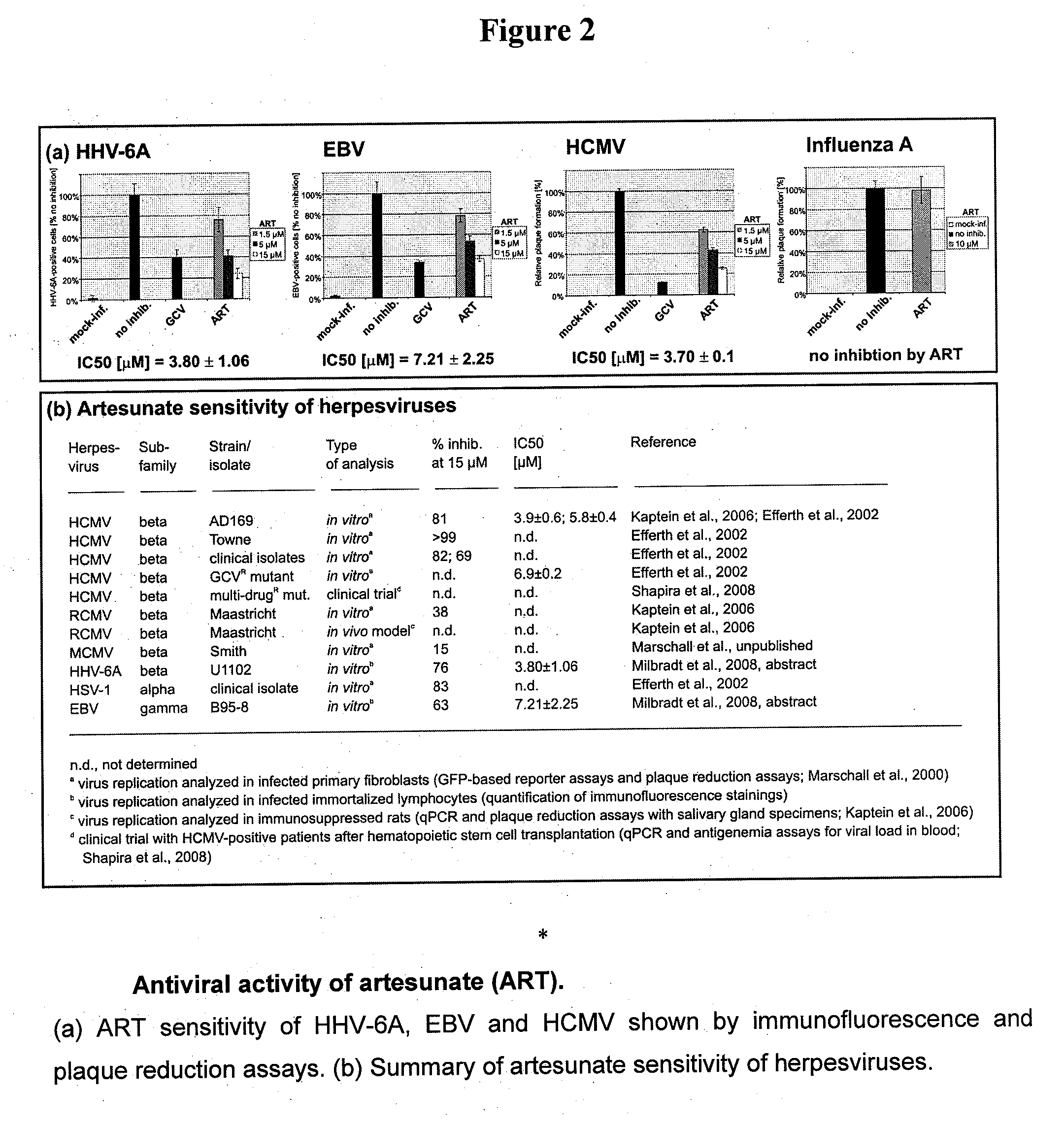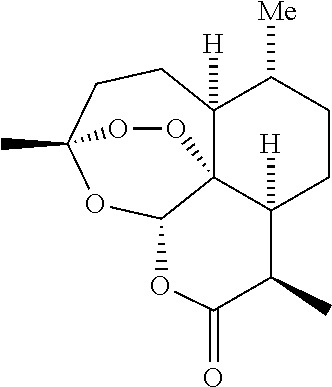Artemisinin and derivatives thereof as antivirals
a technology of antiviral drugs and derivatives, which is applied in the field of natural products, can solve the problems of life-threatening clinical manifestations, clinical applications of these drugs, and the need for artemisinin derivatives, and achieve excellent safety profiles
- Summary
- Abstract
- Description
- Claims
- Application Information
AI Technical Summary
Benefits of technology
Problems solved by technology
Method used
Image
Examples
example 1
Generation of a HHV-6A-Positive Cell Line and Detection of Viral Proteins
[0148]HSB-2 were used for the infection with HHV-6A and prototype strains U1102. An aliquot of the virus-infected cells (stored at −80° C.) was thawed, washed and freshly added to an excess of uninfected cells. After addition of medium, cells were cultivated at 37° C. in a CO2 incubator. After appearance of a virus-induced c.p.e. (cytopathic effect) (app. 5 days), HSB-2 / U 1102 cells were passaged and used as permanently infected cell line and used for the analysis of antiviral drugs. Uninfected HSB-2 cells serve as a control to detect any cell alterations due to other infections, and no c.p.e. were observed in uninfected cells.
[0149]The production of viral proteins can be detected by the HHV-6-specific antibodies available from the HHV-6 Foundation's repository. MAb-05 was positive in Western blot detection procedures, while all other analyzed antibodies were negative (i.e. they lacked HHV-6-specific signals in...
example 2
Inhibition of p41 / 38 Protein Production in HSB-2 / U1102 Cells by Artesunate at an Early Stage of Replication
[0151]HSB-2 / U1102 cells were treated with various concentrations of artesunate (ART) and cultivated for 3 days. Thereafter, cells were lysed and analyzed for the presence of viral p41 / 38 by SDS-PAGE and Western blot detection. As a clear-cut result, levels of p41 / 38 were diminished by ART treatment below the detection limit, while a cellular control protein (β-actin) was not affected or showed only marginal alterations (FIGS. 1A and B, representing two equivalent settings of this experiment). 1.5 μM and 5 μM of ART showed identical results indicating that the inhibitory potential was optimal in a micromolar range. Interestingly, the reference drug ganciclovir (GCV) did not show a similar degree of inhibition. This might indicate different modes of action, and it is believed that GCV does not inhibit production of early protein p41. While GCV is known as an inhibitor of herpesvi...
example 3
Inhibition of HHV-6 Early Protein Production
[0152]MOLT-3 cells are infected with HHV-6B, Z-29 variant, and cultured in the presence or absence of ART for 3 days. Western blot analysis is performed using mAb 6A5D12, which detects both HHV-6A and HHV-6B variants of p41, an Early Protein of HHV-6. ART at 1.5 μM or 15 μM blocks production of detectable amounts of p41, while p41 is detected in untreated controls. Accordingly, it is shown that ART interferes with progression of HHV-6 infection from the latent stage characterized by IE to an active stage where p41 would be produced.
PUM
| Property | Measurement | Unit |
|---|---|---|
| time period | aaaaa | aaaaa |
| body weight | aaaaa | aaaaa |
| time | aaaaa | aaaaa |
Abstract
Description
Claims
Application Information
 Login to View More
Login to View More - R&D
- Intellectual Property
- Life Sciences
- Materials
- Tech Scout
- Unparalleled Data Quality
- Higher Quality Content
- 60% Fewer Hallucinations
Browse by: Latest US Patents, China's latest patents, Technical Efficacy Thesaurus, Application Domain, Technology Topic, Popular Technical Reports.
© 2025 PatSnap. All rights reserved.Legal|Privacy policy|Modern Slavery Act Transparency Statement|Sitemap|About US| Contact US: help@patsnap.com



